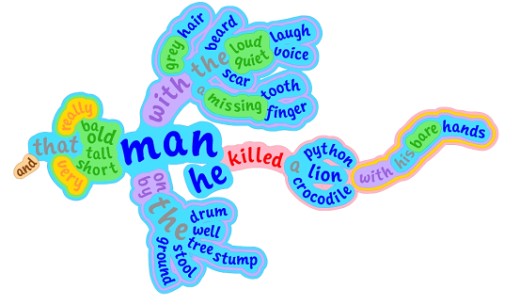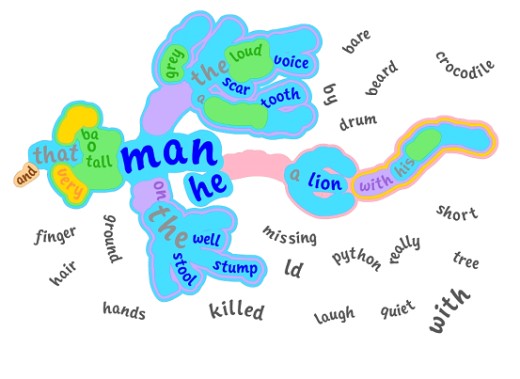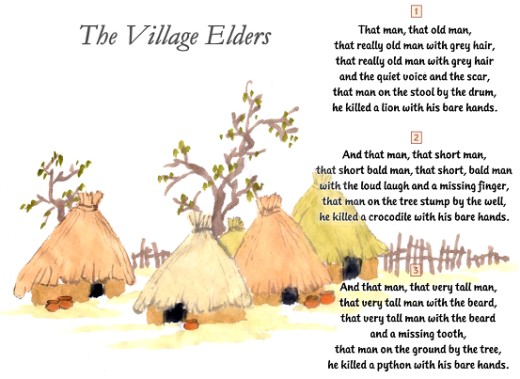The Village Elders - a Language Plant Lesson
David Warr, UK
David is the creator of language plants, a visual way of presenting language, like grammatical mind maps. These materials are wonderful for learning language. They use colour to show word class, and have lots of branches to show lots of words and collocations. David is self-employed and the owner of Language Garden, a company devoted to promoting language plants. www.languagegarden.org
E-mail: david@languagegarden.org
This is a lesson plan for Elementary learners, of any age.
Grammar focus: Noun phrases - how you can add adjectives and prepositional phrases to give more information about the noun.
Topic: describing three old men who were brave when they were younger.
Objectives:
- To listen to and read a text.
- To complete a language plant gapfill.
- To write a short text with a similar grammatical structure.
Language plants are a way of presenting language. They are like grammatical mind maps.
There are two here on this site. This one below is the completed language plant.
Look how you can make lots of different sentences, e.g.
"That short man with grey hair killed a lion with his bare hands."
"That old man with the beard killed a crocodile."
"That tall man on the stool by the well killed a python."

The plant has colours. This is grammatical.
Nouns are blue, adjectives green, verbs red, adverbs orange, prepositions purple, determiners grey, connectives brown.
Look how patterns emerge, e.g. (green) adjective - (blue) noun
old man, loud laugh, grey hair, bare hands.
There are lots of prepositional phrases:
with grey hair, with the scar, with a missing finger,
on the stool, by the well, on the ground, by the tree, on the tree stump.
The other language plant below has words taken out. It is a gapfill, like a puzzle.
Your learners must put the words back in.
It is great fun and full of learning.

Before the lesson: make individual copies of the text and the gapfill language plant.
In the lesson:
Here are some introduction questions:
Are you brave?
What is the bravest thing you have ever done?
What is the most dangerous thing you have ever done?
What stories do you know where people are brave?
Learners discuss in pairs.
Read out this text.
That man, that old man,
that really old man with grey hair,
that really old man with grey hair
and the quiet voice and the scar,
that man on the stool by the drum,
he killed a lion with his bare hands.
And that man, that short man,
that short, bald man, that short, bald man
with the loud laugh and a missing finger
that man on the tree stump by the well,
he killed a crocodile with his bare hands.
And that man, that very tall man,
that very tall man with the beard,
that very tall man with the beard
and a missing tooth,
that man on the ground by the tree,
he killed a python with his bare hands.
Learners can discuss what they heard in pairs.
Give out this text and the gapfill language plant.
The language plant has words taken out of it.
Learners must complete it by putting the black words into the gaps.
Show your learners that there are coloured gaps.
Nouns fit in the light blue gaps.
Adjectives fit in the light green gaps.
The one verb fits in the pink gap.
The prepositions fit in the purple gaps.
Learners can write the words in.
When they have finished, show the complete language plant.
Let learners write their own sentences. Encourage them to add adjectives and prepositional phrases. The three verses are each composed of just one sentence. They are poetic, because they have a nice rhythm, and in each line, the noun phrase is expanded. Your learners can copy this pattern. They will be producing a lovely text, and have great control of grammar.
I hope you enjoy the lesson. I'm sure you will. Your learners will be listening, discussing, reading, writing, studying grammar, using many different intelligences and having fun. Good luck!


Please check the Creative Methodology for the Classroom course at Pilgrims website.


|